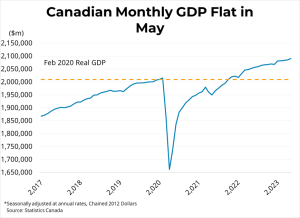 BRITISH COLUMBIA – Canadian real GDP rose 0.3 per cent from the prior month in May, following a 0.1 per cent increase in April.
BRITISH COLUMBIA – Canadian real GDP rose 0.3 per cent from the prior month in May, following a 0.1 per cent increase in April.
Goods-producing sectors of the economy declined 0.3 per cent while services-producing sectors rose 0.5 per cent. Effected by forest fires, Canada’s energy sector declined 2.1 per cent in May. Construction activity contracted 0.8 per cent, driven primarily by lower residential building construction.
Offices of real estate agents and brokers rose 7.6 per cent, led by higher home reselling activity in Canada’s major cities.
Canadian real GDP is now roughly 4 per cent above its pre-pandemic, February 2020 level. Preliminary estimates suggest that output in the Canadian economy declined 0.2 percent in June.
The headline GDP figure was solid in May as the ending of the federal worker’s strike boosted growth, despite rising interest rates and wildfires dragging on the economy. While growth in May came in at 0.3 per cent, the preliminary estimate of a slowdown in June suggests an easing of growth in the second quarter of 2023, estimated at 1 per cent on an annualized basis.
So far in 2023, the Canadian economy has managed to avoid a significant slowdown or recession, but a further slowing of GDP and labour markets is widely expected in the second half of the year.
The softening in GDP and inflation in recent months may provide support for a slowing or pause in rate hikes going forward, but the Bank will be watching closely to ensure inflation continues easing into the fall.
Business Examiner Submitted


